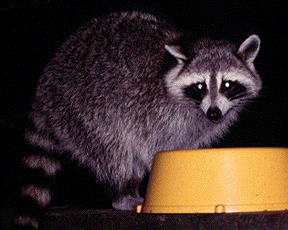

�
��� Rabies is sometimes called hydrophobia,meaning fear of water.� It has affected animals and humans since ancient times.� Because of how long the virus has been around no one knows exactly how it got started.
When the rabies virus enters the body it searches out the nerves where it enters the body. It then must replicate (duplicate) then follow the central nervous system to the spinal column to the brain. The time period between being exposed to the virus and the start of symptoms is called incubation. During the incubation period is the time that allows humans to seek effective treatment from there doctor or hospital. Modern rabies treatment, if begun in time allows our bodies to fight off the virus. Once the disease reaches the brain and symptoms start to show the disease is fatal in both humans and animals.
Infected wild animals can easily pass rabies to pets or other domestic animals. Grazing horses or cattle are infected when bitten by raccoons, skunks or foxes they encounter in their pastures. Dogs and cats can also be exposed in encounters with infected wild animals or other infected domestic animals. Humans who are later in contact with these animals are then placed at risk.
A domestic animal such as dogs, puppies, cats and kittens can shed (transmit to animals and humans) the virus up to 3 days before they show any symptoms of rabies. Unlike dogs and cats, the time that the rabies virus may be transmitted in the saliva of wild animals, such as raccoons, foxes, bats, skunks, bobcats, etc., before showing signs of rabies cannot be predicted.
Most people think rabid animals can be easily spotted because of excessive drool and foaming at the mouth. In fact, most animals will display these symptoms only in the latter stages of teh infection, and sometimes not even then.
A way to identify animals that pose a risk is to recognize unusual, or abnormal behavior. Rabid animals, wild or domestic, may stagger (like they are drunk), appear restless, be aggressive, change in tone of their barks or growls, or appear to be choking. Animals that usually are active at night may become active during the day. Passive animals sometimes become fierce and aggressive.
If your animal comes into contact with a possible rabid animals, do not handle your animal with your bear hands as the saliva on your animal from the possible rabid animal can transmit the virus to you.
Stay away from all wild animals and unknown dogs and cats.
Teach your children the importance of staying away from wild animals and unknown dogs/puppies and cats/kittens. Make sure they tell you immediately if they are bitten or scratched by any animal.
Avoid any animal acting unusual.
Never try to break up an animal fight by putting your hands or any part of your body between the animals, even if your pet is involved.

Wash the affected area of exposure immediately with soap and water. Contact your physician or health department about advice on treatment.
All animal bites, whether the animals is wild or domestic, vaccinated or not, must be reported to the Health Department or Animal Control.
If you think your pet may have come into contact with a rabid animal or may have the rabies virus contact Animal Control right away.
If your animal fights with or has other possible contact with a possible rabid animal, contact Animal Control for instructions. Do not handle your pet with your bear hands.
Pennsylvania 1984 Texas 1985 Oregon, 1989
Texas, 1990 Texas, Arkansas, and Georgia, 1991 California, 1992
Texas and California, 1993 New York, 1993 West Virginia, 1994
Miami, 1994 Alabama, Tennessee, and Texas, 1994 California, 1994
Connecticut, 1995 Washington, 1995 California, 1995 Florida, 1996 Kentucky and Montana, 1996 New Hampshire, 1996 Montana and Washington, 1997 Texas and New Jersey, 1997 Virginia, 1998
California, Georgia, Minnesota, New York, and Wisconsin, 2000
Cases of rabies in human beings in the United States, by circumstances of exposure and rabies virus variant, 1980-1997*
Cases of rabies in human beings in the United States, by circumstances of exposure and rabies virus variant, 1990-1999*
Cases of rabies in human beings in the United States, by circumstances of exposure and rabies virus variant, 1990-2000
Exposure to a Rabid Cow -- Pennsylvania 1982
Mass Treatment of Humans Exposed to Rabies ? New Hampshire, 1994
Mass Treatment of Humans Who Drank Unpasteurized Milk from Rabid Cows
Animal Rabies ? South Dakota, 1995
Rabies in a Llama -- Oklahoma
Rabid Bear Cub Iowa, 1999
Rabies -- United States, 1981 Rabies Surveillance, United States, 1987
Rabies Surveillance, United States, 1988
Extension of the Raccoon Rabies Epizootic -- United States, 1992
Raccoon Rabies Epizootic -- United States, 1993
Raccoon Rabies Epizootic ? United States, 1996
Raccoon Rabies Epizootic -- United States and Canada, 1999
Raccoon Rabies -- Mid-Atlantic States
Cases of rabies in the United States and Puerto Rico, by state and category, 1998
Cases of rabies in the United States and Puerto Rico, by state and category, 1999
Rabies cases diagnosed in the United States, 1999
Using a Spatial Filter and a Geographic Information System to Improve Rabies Surveillance Data
Translocation of Coyote Rabies ? Florida, 1994
Reports Imported Dog and Cat Rabies -- New Hampshire, California
An Imported Case of Rabies in an Immunized Dog
Bear Places Zoo Visitors, Others At Risk for Rabies
Risk for Rabies Transmission from Encounters with Bats, Colorado, 1977-1996
Imported Human Rabies -- Australia, 1987
International Notes Bat Rabies -- Europe
First Case of Human Rabies in Chile
Rabies in Marmosets
Reports Rabies in a Javelina -- Arizona
Human Rabies -- Kenya
Reports Human Rabies Acquired Outside the United States
Human Rabies Despite Treatment With Rabies Immune Globulin and Human Diploid Cell Rabies Vaccine -- Thailand
Imported Human Rabies -- France, 1992
Imported Human Rabies
Pages written just for young people
Pet Overpopulation
Poems and other writings
Nickie Dog's Home Page
Carole Gunn